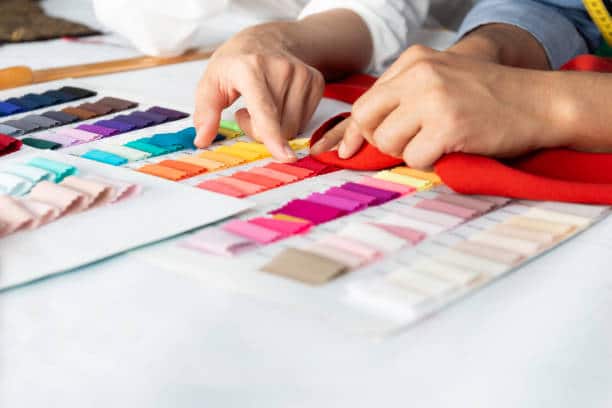That’s why starting a clothing business from home is a great business idea, which everyone can try. That, combined with the fact that e-commerce has become a major industry and people now naturally want to personalize the clothes they wear, there’s no better time than now. Whether it is your first business or you’re a professional fashion designer this complete guide will help you set up a successful from home small clothing business.
1. Define Your Brand and Niche

The initial process of beginning your clothing business is to identify the brand and the actual market specialization. The fashion industry is globally saturated and therefore an identification of a particular market niche will assist. It might be anything from eco-chic to urban wear, vintage clothing, bespoke clothing or even customized wear. Here’s how to narrow it down:

- Identify your passions: Which type of clothing gives you the greatest enthusiasm? You should determine your style, values and the type of change that your brand is going to bring.
- Research your target audience: Who is going to be most interested in your clothing and are they the target audience you should be directing your efforts at? Are they teenagers, college goers, beginning career people, or individuals with children of their own? Knowledge of your audience assists in the process of designing, marketing, and setting the best price in relation to your clients.
- Analyze competitors: See what your competitors, whom you are in the same category, are doing. This will therefore assist to identify the areas that are lacking quality service providers and also how you can stand out among the competitors.
Your brand should have one brand identity, brand voice, and brand appearance. A well built brand in customers minds is effective in making customized business because customers will trust products or services from that particular brand.
2. Develop a Business Plan
A good business plan is always credibly important even if the business is a home-based business with little capital investment. They will look like your business plan because they will act like your compass pointing out where your business is and where it should be in the future. Here’s what your plan should include:

- Mission statement: It is high time to declare what your business is all about and what goals you strived to achieve.
- Market analysis: Provide information about the clothing industry, your specialization, and your audience. focusing on possible advantages and effective threats.
- Product offerings: Provide localized details about what kind of clothing you will be selling such as the type of cloth used in the design and special features.
- Marketing and sales strategy: Explain how you are going to appeal to the customers of your business. Which social media platforms, influencers or online advertising will you use? If any specify your strategy of pricing as well as the promotions that you are undertaking.
- Financial plan: Calculate the fixed costs that need to be incurred to start business, the range in which the business will price its products and the amount of profit that is feasible in that range. Also, do not forget about material, shipping, website, and other marketing related costs.
- Growth plan: Some of the things that need to be defined are: when you are planning to scale your business and how.
A professional business plan is useful not only in terms of maintaining a systematic organization but also in terms of finding an investor or partner if necessary.
3. Source Your Materials
Quality is therefore determined by material used in your clothing business. Action: Always make sure you use good quality fabrics and garments when either sewing everything by themselves or outsourcing production. Here’s what to keep in mind:

- Find reliable suppliers: Identify suppliers who source materials that you can afford and are usable in the design project. Most fabric wholesalers for some reason are willing to ship fabric to small businesses.
- Consider sustainability: Sustainable fashion is becoming the new trend. If your company’s personality is aligned with environmentally friendly products, then choose fabrics such as organic cotton, hemp or recycled materials.
- Order samples: When intending to place an order for large quantities of fabric, it is always advisable to ask for sample fabrics for the specific products because this way you are certainly assured of fabrics that will meet your quality standards in as much as quality, texture and durability are concerned.
Here, ensure the manufacturer that you’re working with has a perfect understanding of your designs and what you expect from him. Be close to your supplier because a close working relationship with your supplier can avoid problems in the future.
4. Create Your Designs
The most exciting part of fashion designing is to design your collection. Finally, the illustrations can be done with the help of a pencil and paper or using the appropriate computer programmes and graphic software; The overall style, theme, or concept of your sketches should correspond to your brand and appeal to your audience. Here’s how to get started:

- Stay inspired: Always search for references from fashion shows, fashion magazines, fashion specific social network sites or a nearby fashion store. Remember to keep up with what everyone is wearing while staying astride of the trends that will make you a cut above the rest.
- Create prototypes: If you are from ground up designing then, make first-cut or first-time product mockups or models. This is very important since a full run of cloth and garment spoils the material if it does not fit or look good or has some defects.
- Experiment: One should also not be too rigid with the specific type of fabric that one is using, the colour and the design of the clothes. Initial attempts are a good idea in the hope that the best designs can be brought out.
- Use design software: Graphics such as Adobe Illustrator or any programme used to make patterns is recommended when it comes to creating designs for production.
In this case, cross check that your designs are consistent with your brand’s theme. In this case, one should bear in mind that some constant repelling is necessary for a brand to become easily recognisable in the sphere of fashion.
5. Set Up an Online Store
Probably the most obvious and important thing is the idea to make a presence online or to have an online store. For example, Shopify, Etsy, and BigCartel are excellent if you want to sell clothes from home. Here’s how to get started:

- Choose the right platform: Pay attention to what it can do – for example, it can track your inventory, process payments and ship out items. Shopify will serve those who are looking for a one stop shop, whereas, Etsy is preferable to those who want more customization, unique designs.
- Design your website: Your website should be able to create the brand image. Select a neat and elegant design of your shelves to ensure that the customers are easily able to go through your collections.
- Take professional photos: You need to take quality photos of your clothing. Taking up a good source of lighting should be used and using models to display one’s creations should also be encouraged.
- Optimize product descriptions: This is because you need to write detailed descriptions about the fabric, the fit – and anything special about each of the items that you are writing about.
Your website is going to be your main selling tool; therefore, work on making your site as responsive as possible, both to PC visitors and users on the go.
6. Market Your Clothing Business
This being the case, you need to apply more effort in making visitors and customers come to your online store. This ensures that your brand is seen and bought thus helping you in marketing. Here are some strategies to promote your business:

- Leverage social media: Companies engaged in the fashion industry should be on Instagram, Pinterest, or TikTok. Stay active on your page, respond to comments and create or participate in campaigns to bring people together in support of your brand.
- Run promotions: Beginner’s luck, seasonal sale, or free shipping on orders to convince the new clients.
- Build an email list: Organize the collection of email addresses from those visiting your website. These emails can be used in sending newsletters, about newly launched products, and special offers.
- Collaborate with influencers: Collaborating with fashion bloggers or influencers with good relationships with your business will increase the visibility of your business.
The overall concept is to maintain a constant and steady marketing message to your customers.
7. Manage Your Inventory and Finances

Filing is part of organizational practice that is crucial when sales start coming into the business. Inventory management will help to prevent a situation of either running out of stock or having too much of the wrong stock. Here are some tips for managing inventory and finances:
- Use inventory software: All platforms have predefined features on how they can assist you in tracking your stock levels for example Shopify or Square. Scrap inventory is an important indicator that should be strictly monitored to be ready to satisfy the public’s demand anytime.
- Set up accounting: Make sure you recording all your expenses, including all the money you have received from your sales and profits. There are many software available in the market, such as QuickBooks, wave, etc. it provides an easy way to manage your Accounts efficiently and get ready for the tax season.
- Minimize waste: If you are using direct production for apparels, it is hoped that there will be lesser wastage on the fabric by maximizing the patterns and ways of cutting. This will not only reduce costs but also make the company respond to environmentally conscious customers.
8. Scale Your Business
When your clothes business venture is home based, you should think of how to expand it in the future. Here’s how you can expand while maintaining the quality and integrity of your brand:
Outsource production: If this demand will still rise beyond what you can handle alone, find a manufacturer to help you produce more while concentrating on quality.
- Expand your product line: Offer the customers new products that have never been worn before, like accessories, clothes adapted for the specific seasonal conditions, or pieces of clothing, which are indicated as exclusive.
- Open a physical store or pop-up: In case you wish to branch out of the online business model, you may lease a small store or use window displays to sell your products to walk-in customers.
- Hire help: Thus, as your company expands, there are going to be the problems with the production line, marketing, or customer relations. You can hire few employees so that you can have more time for design and expansion.
Conclusion
Fashioning a clothes design home-based business is not a walk in the park as it is equally characterized by innovative, commitment and sound planning. This way you can set the tone for the remainder of your business lifecycle by creating awareness of your brand, writing and implementing a business plan, securing a dependable supply of quality material, and marketing your product to the target consumer well enough to ensure the company’s success. Never forget that fluctuation combined with a constant direction must be the fashion’s vector for success.



